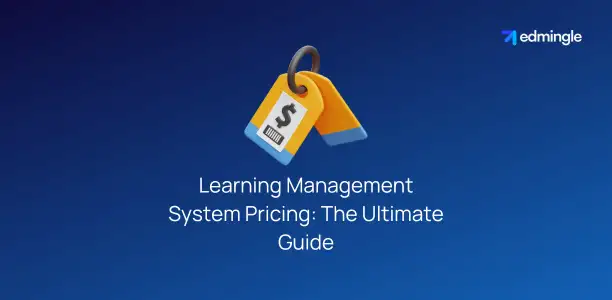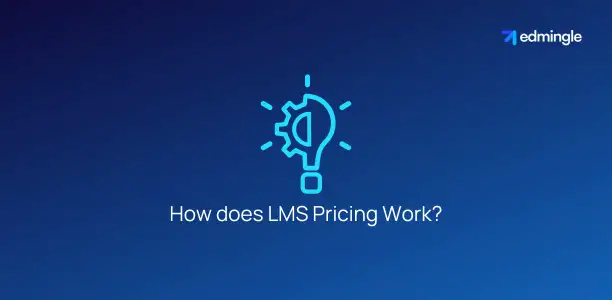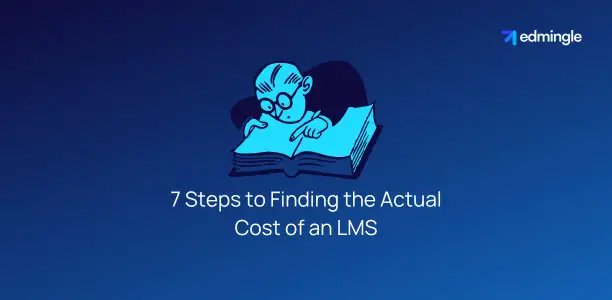
Today, knowledge is just a mouse-click away. Many educational institutions are shifting towards an LMS to empower their learners.
But how much does it truly cost to enter this world of digital learning?
With the many options we have today, exploring about learning management system pricing can be challenging. But fear not!
In this guide, we’ll explore in-depth about LMS pricing. By the end of your reading, you’ll be better prepared to assess which LMS suits your needs the best.
How does LMS Pricing Work?

First things first, what factors into the cost of an LMS? There isn’t a one-size-fits-all answer. LMS pricing depends on several variables. These include:
- features & functionalities,
- user capacity,
- customization & branding,
- hosting type,
- support & training required,
- the LMS vendor’s reputation, market presence, etc.
The step of LMS pricing comparison comes somewhere after taking an LMS demo. And it’s crucial to look beyond just the initial setup or development cost.
Consider your long-term needs, potential growth and how much support you might need from the provider.
Check our blog on LMS features to read in detail about key features.
7 Major Learning Management System Pricing Models

Different models cater to different needs, organizational sizes, and budgets. This brings in a multitude of LMS pricing models.
1.Subscription-Based
- Monthly or Annual Fees: This model charges users a ongoing costs as a recurring fee, typically monthly or annually. The fee often depends on the number of active users or active learners. And sometimes on the features or services included.
- Scalability: Its suitable for organizations of all sizes. As it allows for easy scaling up or down based on the number of active users.
2.Per User/Per Learner
- Charge Per User: Costs are directly tied to the number of active learners or users registered on the platform. This can be ideal in the case of an LMS for small business. But can become expensive as the number of active learners grows.
- Flexibility in User Management: Offers flexibility as organizations pay only for the actual number of users accessing the LMS.
Read about Edmingle’s scalability and flexibility.
3.License Fee
- One-Time License Fee: Organizations pay a one-time fee to use the software indefinitely. This model may also involve an annual license fee for customer support & service, maintenance, or updates.
- Long-Term Investment: Suitable for an LMS for educational institutions or large organizations that prefer to have control over their LMS. Without recurring subscription fees.
4.Pay-Per-Course
- Fees Based on Course Consumption: Organizations pay for the number of training courses accessed or the number of course enrollments. This model is beneficial for organizations that need to train users on a limited number of courses.
- Cost-Effective for Specific Needs: Ideal for businesses looking for targeted training without the need for a full-scale LMS.
Since we talked about coset-effectiveness. You might like to read how Edmingle reduces your operational cost by 20%.
5.Free
- Limited Features: Some LMS platforms offer a free version with basic features. These are often designed for small organizations or trial purposes.
- Upgrade Options: Free models may provide options to upgrade to more comprehensive paid versions with additional features and support.
To know more about free LMSs, check our blog on Best Free LMS.
6.Freemium Model
- Core Features for Free: Offers core features for free, with advanced features, additional storage, or support available for an additional fee.
- Flexibility: Allows organizations to start with basic functionalities and upgrade as their needs grow.
Also Read: Difference Between Free LMS and Paid LMS.
7.Custom Pricing Option
- Tailored Pricing: Some LMS providers offer custom pricing based on the specific needs, features, and scale of the organization’s training program.
- Consultation Required: Organizations typically need to consult with the LMS provider to get a quote based on their unique requirements.
In short, choosing the right LMS pricing model depends on several factors. And it’s important to carefully evaluate your needs against the costs and benefits before making a decision.
6 Important Factors to Check in an LMS Pricing
When it comes to selecting an LMS, price is undoubtedly a significant consideration.
But it’s also crucial to recognize that not all LMS platforms are created equal. And before you invest in an LMS, here are 6 important factors to take into account:
| 1.Scalability: Does the LMS pricing model allow for adding more users easily? Is there a significant price jump when scaling up, or is the growth curve reasonable? | 2.Ease of Use: How intuitive is the online learning platform? If you’re spending more for an easy-to-use LMS, think of it as an investment in efficiency and reduced training time. |
| 3.Mobile Solution: Does the LMS offer a mobile-friendly interface or app? While some LMS platforms may charge extra for this feature, consider the benefits of accessibility for your learners. | 4.Third-Party Integrations: What integrations does the LMS support? If there’s a higher cost associated with better integration capabilities, weigh it against the potential time and effort savings. |
| 5.Customizability: How customizable is the platform? If the LMS charges extra for branding or other unique modifications, evaluate the importance of these features for your organization. | 6.Analytics: What kind of detailed reports and analytics does the LMS offer? A slightly pricier platform with comprehensive analytics might provide more value in the long run by informing better decision-making. |
When determining which LMS is right for you, it’s essential to look beyond just the base price and consider the overall value each platform offers.
If you want to know more about customizability & branding, our following blogs will be helpful for you:
7 Steps to Finding the Actual Cost of an LMS

It quickly becomes apparent that understanding the true cost of an LMS isn’t as straightforward as one might hope.
To make an informed decision, it’s essential to peel back the layers and evaluate every aspect of LMS pricing.
Here are the 7 steps you need to follow:
- The Visible Costs: These are the expenses that are front and center in most LMS advertisements and discussions. These numbers, however, are only the tip of the iceberg.
- Monthly or annual costs/subscriptions
- Per-user fees
- Licensing fees
- Pricing Package: Understanding the pricing model is essential.
- Per User Pricing: You pay based on the number of users.
- Flat-rate Subscription: A fixed fee, regardless of user numbers.
- Tiered Pricing Method: Cost varies depending on the package of features chosen.
- Setup Fees: Many providers charge a one-time setup fee, covering implementation, data migration & training.
- Hosting Fees: Depending on the hosting type, there might be costs involved:
- Cloud Hosting: Typically a recurring fee, offering ease of maintenance and updates. To know more about this type, check our blog on SaaS LMS (cloud-based LMS).
- Self-hosting: Initial costs can be hefty, and you bear the brunt of maintenance.
- Customization Costs: Tailoring the LMS to your branding or specific features can come at a premium. Whether it’s a unique user interface, specific integrations, or other tailored functionalities. Customization usually has associated costs.
- Hard Costs & their Complexity: Hard costs are explicit, like purchasing hardware for a self-hosted LMS or buying specific modules. Their complexity lies in their potential for unforeseen expenses. Maybe that hardware requires a specific cooling system or particular security measures.
- Hidden Costs: These are costs that aren’t immediately obvious. Such as regular software updates, additional training sessions or third-party integrations. It might also include support and troubleshooting services.
When looking at LMS pricing, the key is to consider both immediate and long-term expenses. By understanding the various types of LMSs, you can ensure you’re making a well-informed investment.
Also Read: Best LMS for Selling Courses.
8 Steps to Selecting the Right LMS Pricing Structure For You
Selecting the right learning management system pricing structure involves the following 8 steps:
| 1.Assess Your User Base (Size & Scalability) | Consider your current business size, user base and potential growth. Subscription-based or per-user models might suit fluctuating sizes, while a periodic license fee model may be cost-effective for a stable, large user base. |
| 2.Identify Your Learning Objectives (Course Volume & Type) | Determine the volume and type of online courses you plan to offer. Pay-per-course models can be economical for limited course offerings, whereas subscription models may be better for extensive, diverse training programs. |
| 3.Evaluate Feature Requirements (Essential vs. Advanced Features) | Understand the features critical to your training program’s success. Freemium or free models can suffice for basic needs, but more comprehensive features may necessitate a subscription or custom pricing model. |
| 4.Consider Your Budget (Upfront Costs vs. Recurring Fees) | Analyze your technology budget to decide if a one-time license fee or recurring subscription fees align better with your financial planning. Remember to factor in potential hidden costs like level of customization, implementation, and support. |
| 5.Plan for Long-Term Scalability (Future Growth) | Choose a pricing model that accommodates future growth in terms of users, online courses, and complexity without significant additional costs. |
| 6.Test and Evaluate (Free Trials and Demos) | Utilize free trials and demos to evaluate how well an LMS meets your needs within its pricing model. This hands-on experience can highlight the value and potential limitations of the system. |
| 7.Consult with Stakeholders (Feedback from Users & Instructors) | Gather input from potential LMS users, instructors, and IT staff to ensure the chosen model meets the diverse needs of all stakeholders. |
| 8.Review Terms and Flexibility (Contract Flexibility) | Check the flexibility of contracts or agreements to ensure you can switch pricing plans or terminate services without significant penalties should your needs change. |
By thoroughly assessing these aspects, you can select an LMS pricing structure that not only fits your budget. But also supports your organizational learning objectives effectively.
Summary of Learning Management System Pricing
The quest to find the perfect LMS can feel never ending. But LMS pricing models are as varied as the needs of the organizations they serve.
The pricing options are plentiful. Each with its own set of benefits and use cases. It’s clear that the right choice is not just about the price tag.
But about finding a solution that aligns with your educational goals, supports your growth, and offers the flexibility your organization needs. To thrive in an ever-changing educational environment.
The key lies in understanding your unique requirements. And how different learning management system pricing models can meet those needs over the long term.
FAQs around Learning Management System Pricing
1.Where can you find the details on LMS pricing?
The best place to start is the official websites of LMS providers. Most companies like Edmingle provide pricing details on their sites. Additionally, eLearning industry publications, forums, and reviews often offer insights into pricing and user experiences.
2.How does the cost of an LMS impact your budget?
LMS pricing impacts your budget in direct and indirect ways. Direct costs include the LMS platform cost, setup and maintenance. Indirect costs might encompass training, potential downtime, or lost productivity during transitions. When budgeting, account for both immediate and long-term costs to ensure you’re making a sustainable investment.
3.How to know if you are buying or investing in an LMS?
If you’re merely looking for a short-term solution with basic functionality, you’re buying. But if you’re looking for an LMS that aligns with your long-term goals, then you’re investing. An investment in LMS should yield returns in terms of improved training efficiency, learner engagement and business growth.

Leave a Reply